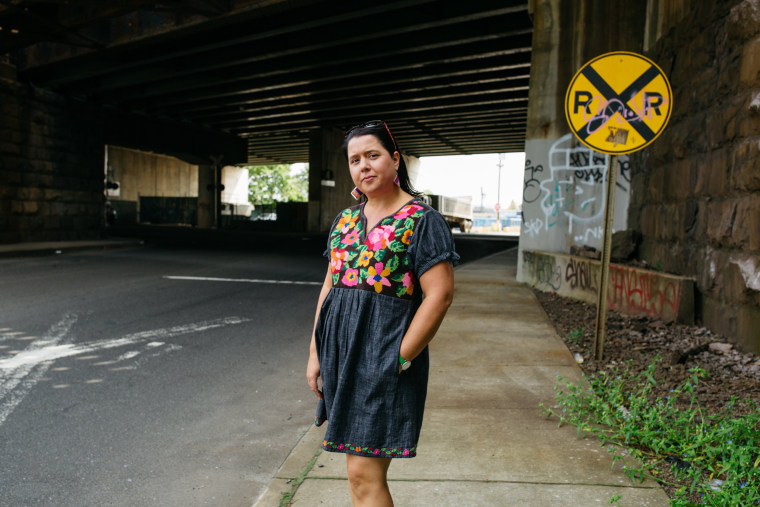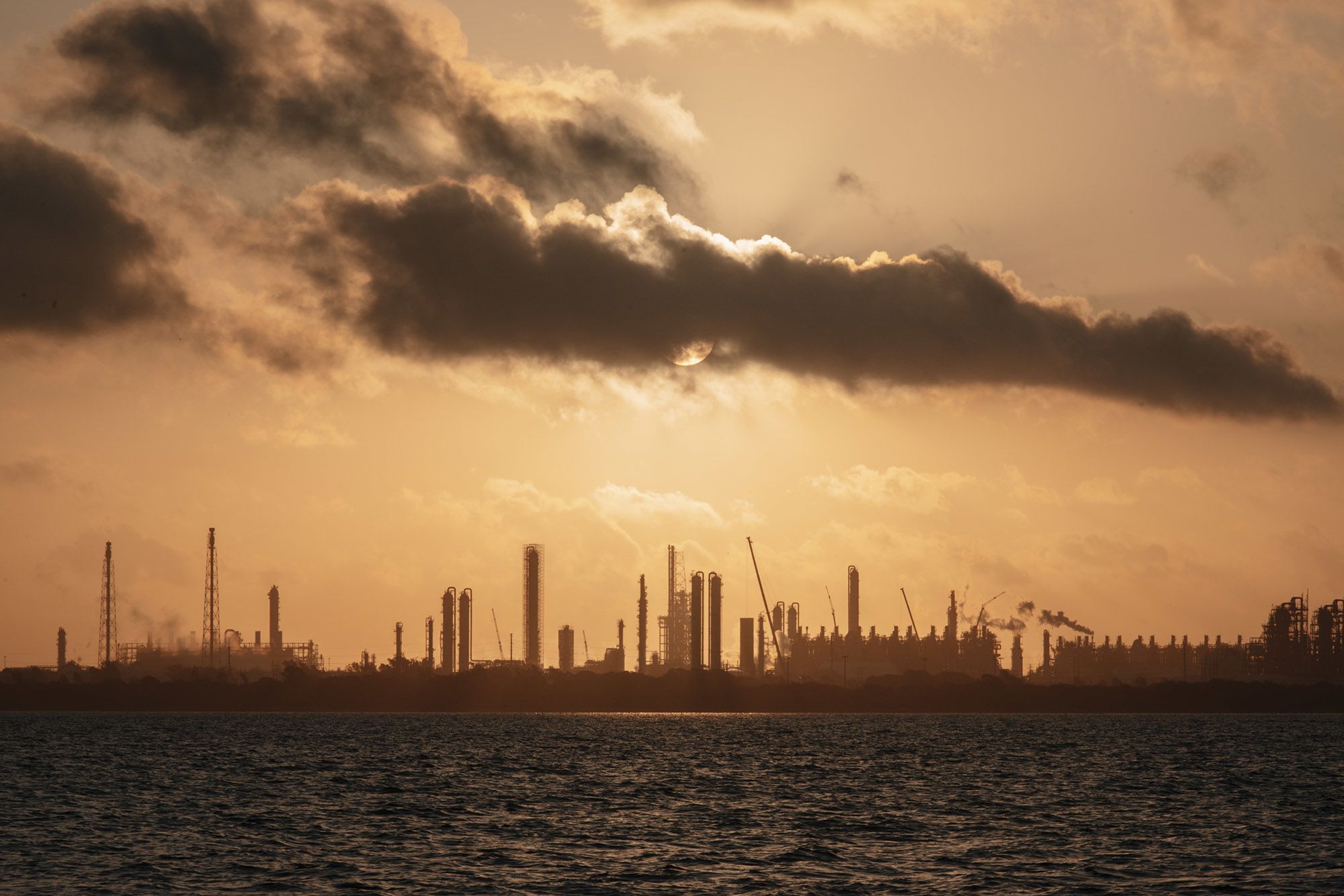This article was published in partnership with Inside Climate News, a nonprofit, independent news outlet that covers climate, energy and the environment, and the Texas Observer, a nonprofit investigative news outlet. This is part 2 of "Super Threats," a series on Superfund sites and climate change. Read part 1 here.
NEWARK, N.J. — In the bewildering days after Superstorm Sandy roiled the Eastern seaboard in October 2012, shredding coastal communities with hurricane-force winds and once-in-a-generation flooding, Ana Baptista ventured into the Ironbound, an industrial neighborhood of Newark.
Baptista, a community advocate, brought cleanup supplies for residents of the mainly immigrant enclave of New Jersey’s largest city, assisting them in a blend of English, Spanish and Portuguese. She found backed-up sewers and homes soaked in brackish water from the nearby Passaic River that had reached first-floor windows. One woman was aghast to discover an oil slick and dead fish sloshing in her basement, bobbing along the scummy surface of the floodwaters like a toxic soup.
“It smelled like poop and chemicals. It was disgusting,” recalled Baptista, an Ironbound native and a former director of environmental justice and planning at the Ironbound Community Corp., a local nonprofit.
The devastation from the storm was an eye-opener in a way that still worries Baptista and many in the Ironbound today: Nearly eight years later, people continue to fear the long-term health consequences of the water and muck that swept into their homes.
That’s because crammed among the Ironbound’s 55,000 residents, who live mostly in apartment buildings and multifamily housing, are factories and warehouses, a power plant, chemical refineries, the state’s largest garbage incinerator and a Superfund site so contaminated with hazardous waste that the federal Environmental Protection Agency is authorized to investigate and force polluters to clean up.
New Jersey has 114 Superfund sites, the most in the nation, and Newark is home to four of them. The one in the Ironbound, a former chemical plant where cleanup is priced at $1.4 billion, is especially problematic: It’s one of nine in the state, and 74 nationwide, that not only are vulnerable to the effects of climate change but contain uncontrolled toxic wastes that could damage human health, an investigation by Inside Climate News, the Texas Observer and NBC News found.
The reporting on the Superfund program uncovered hundreds of sites across the country, including the one in the Ironbound, that have already been hit by severe storms, raising environmental advocates’ fears of what could happen as sea levels rise and hurricanes worsen. Yet the investigation found that the Trump administration has largely abandoned plans written by all 10 EPA regional offices that factored climate change risks into Superfund planning and remediation.
And even at sites like the Ironbound, where Obama-era cleanup plans remain on the books, the work is slow — often taking decades — and the preparations have not kept up with rapidly advancing scientific knowledge about the threats posed by climate change, environmental advocates and experts say.
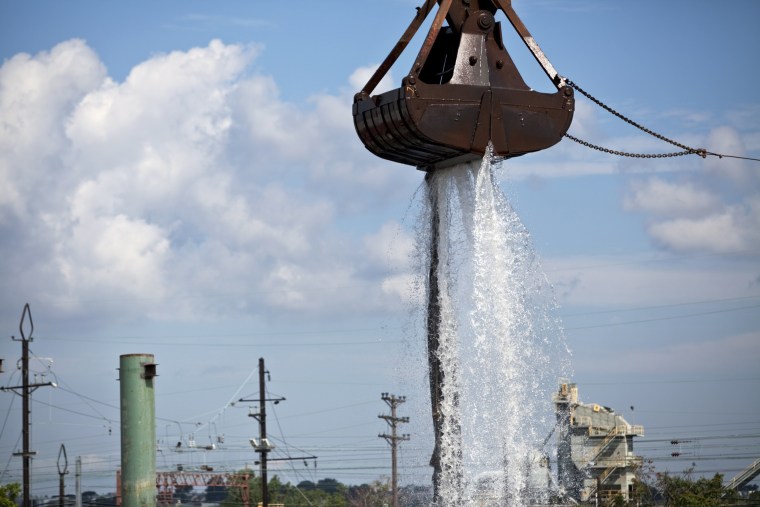
“It is critical that contamination be properly cleaned up,” said Ashaki Rouff, an associate professor of earth and environmental sciences at Rutgers University-Newark, adding that climate change and extreme weather events can pose a high risk of “stirring up” the toxins.
The planned remediation of the Ironbound site grows more urgent by the day, community members say. It is one of the largest and most expensive cleanup projects in the Superfund program’s four-decade history, covering a former Diamond Alkali chemical plant, the lower Passaic River and Newark Bay. And there’s still no target date to complete the cleanup.
For many residents of Newark, its concentration of Superfund sites underscores two New Jerseys: one of tree-shaded suburbs where wealth and political leverage guard communities from outside corporate interests and rampant pollution, and the other, of lower-income and predominantly Black and brown residents who have endured decades of discriminatory housing policies only to find their communities squeezed by heavy industry and used as dumping grounds for hazardous waste.
The disparity is frustrating for Ironbound activist Arnold Cohen, 72, who organized marches in the early 1980s demanding state and federal investigations into the toxic waste at the site that revealed dioxin contamination obscured from the public for decades. The dioxin, and other cancer-causing chemicals, had been discharged into the Passaic River.
Among the demonstrators were children, including a young Baptista — emblematic of how the same fight continues for yet another generation, Cohen said.
“Sometimes people forget about things or say, ‘We just have to live with this.’ Or they throw up their hands and ask, ‘Why are we wasting our time?’” Cohen added. “It feels like we’ve been forgotten. But some of us won’t let that happen.”

A ‘crime scene’
Environmental advocates say the stakes are high to clean up the Superfund site in the Ironbound, the most densely populated neighborhood in Newark. According to the EPA, the Passaic River’s waters are coated with toxic contaminants, including thousands of pounds of mercury, PCBs and other heavy metals that have embedded in the sediment — a reminder of the city’s legacy as a commercial hub producing leather, beer and paint.
Those same advocates believe Newark, a majority-Black city, and places like it deserve increased attention from federal and state governments that have historically ignored appeals from communities of color for cleaner air and water, and limits to industrial pollution.
During the 1950s and ’60s, Diamond Alkali produced Agent Orange, an herbicide used by the U.S. military in the Vietnam War to destroy dense vegetation. About every other week, the factory dumped dioxin, a chemical byproduct, into trenches that flowed into the Passaic, according to court documents filed in 1992 by Diamond Shamrock, Diamond Alkali’s successor, in a New Jersey Superior Court case against dozens of its insurance companies. Trucks rolling in and out of the nearly 6-acre parcel also tracked dioxin through the neighborhood.
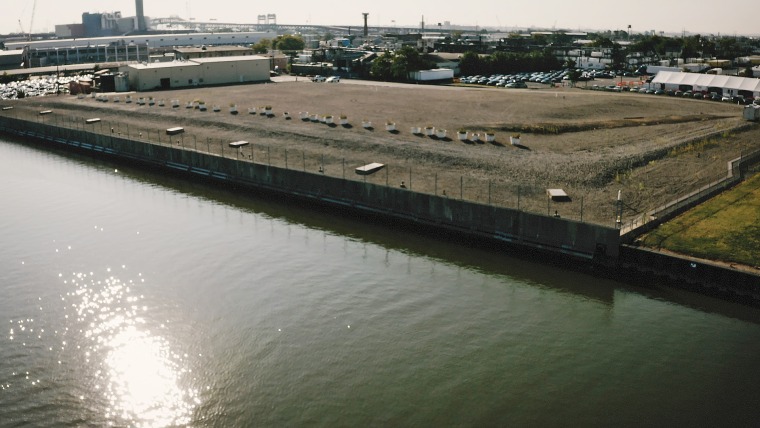
In 1983 — 14 years after the plant closed — the community compelled state and federal investigators to order samples from the site, the surrounding streets and the river. The testing uncovered alarming levels of dioxin, a carcinogen linked to reproductive and developmental problems in humans. According to the state, soil samples at the site showed concentrations of up to 51,000 parts per billion, and off-site, up to 15 parts per billion. In 1984, the Centers for Disease Control and Prevention established just 1 part per billion in soil as a “level of concern” in residential areas.
Today many longtime residents can recall stories of people playing in and around the Diamond Alkali site before it was capped, or eating food grown in soil potentially tainted by chemicals like dioxin. Nonetheless, there are few studies looking at long-term health effects, birth defects and cancer, environmental advocates say.
In 1984, the EPA placed the former Diamond Alkali plant on its Superfund National Priorities List, among hundreds of the worst hazardous waste sites in the nation requiring substantial and costly cleanup. The factory was demolished and buried, and the poisoned property was capped two decades ago with concrete and gravel. But an approximately 17-mile, serpentine stretch of the Passaic, wending around suburban communities outside of New York City and feeding into Newark Bay, remains so tainted by dioxin and other chemicals that people are fined up to $3,000 if they’re caught crabbing.
The EPA wants that portion of the river cleaned up, saying that the contaminated sediment “poses a significant threat to people’s health and the health of wildlife,” with the primary risk coming from consuming fish and shellfish from the river.
Last year, Sen. Cory Booker, D-N.J., a former Newark mayor, lamented how corporate greed had turned the natural resource into “New Jersey’s biggest crime scene.”
The former Diamond Alkali company is largely responsible for the contamination that fouled the property and the adjacent river, according to the EPA. The company later changed its name to Diamond Shamrock and then became Maxus Energy Corp. of Texas, which filed for bankruptcy in 2016 after it was acquired by YPF S.A., Argentina’s state-owned oil company. New Jersey lawmakers have since accused YPF of trying to get out of paying its share of the cleanup.
The company did not return requests seeking comment, but Maxus suggested in a 2008 counterclaim in New Jersey Superior Court against the state over cleanup costs that it was a “scapegoat” and that the river was polluted by manufacturers and municipalities long before Diamond Alkali and its predecessors began operations in the 1940s.
Meanwhile, dozens of other businesses and entities, including Fortune 500 companies, that are potentially culpable in polluting the river or that had inherited the liability, would be expected to pay for the river’s remediation, according to the EPA.
Following Sandy, one of the most destructive storms in modern U.S. history, Baptista said she was hoping the state and the EPA would respond quickly and test the water in the Ironbound, to allay people’s fears. The EPA eventually tested a handful of homes weeks later, she said, but by then, most of the water had receded or been purged from properties. The EPA at the time said there was no immediate hazard connected with the Superfund site, and statewide research that examined the effect of Sandy on people’s health didn’t focus on Newark.
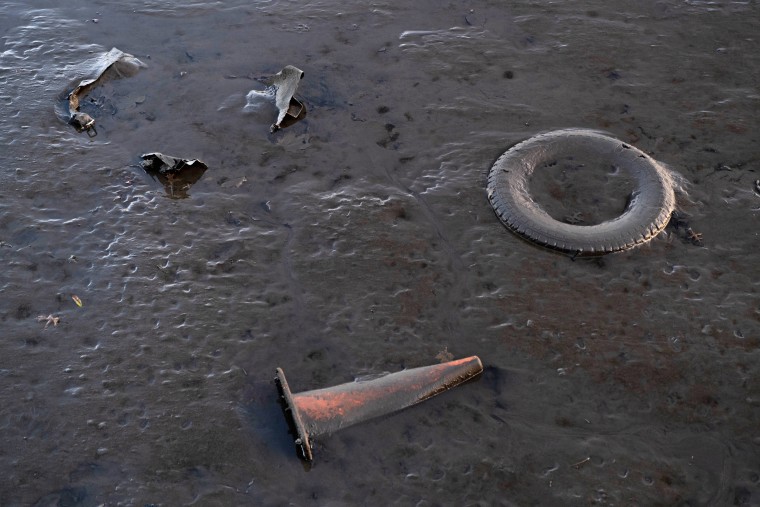
Baptista, now an assistant professor at The New School in New York City focusing on environmental policy and climate justice, remains skeptical.
“They did not find high levels of dioxin,” she said, “but we don’t know how much people were exposed to.”
A river’s rebirth?
Former EPA officials worry that the needs of cities like Newark will be forgotten as the agency deprioritizes environmental justice issues. The agency has proposed the elimination of an Obama-era program that aided low-income communities and communities of color harmed by Superfund sites from its fiscal 2021 budget.
Communities saddled with “the worst kinds of sites don’t have the same muscle to fight for themselves,” said former New Jersey Gov. Christine Todd Whitman, a Republican who served as EPA administrator from 2001 to 2003.
Still, cleanup of the Superfund site in the Ironbound and the Passaic River remains one of the most elaborate in the nation.
It took almost two decades after the site was placed on the Superfund National Priorities List in the early 1980s for the former Diamond Alkali factory to be razed and covered in concrete in 2001. In 2012, the EPA completed another cleanup phase, removing about 40,000 cubic yards of highly contaminated sediment in the Passaic River immediately around the shuttered property. In 2016, the agency issued a formal plan to remediate and cap the lower portion of the Passaic River, an 8-mile zone that includes a broader area around the Diamond Alkali site.
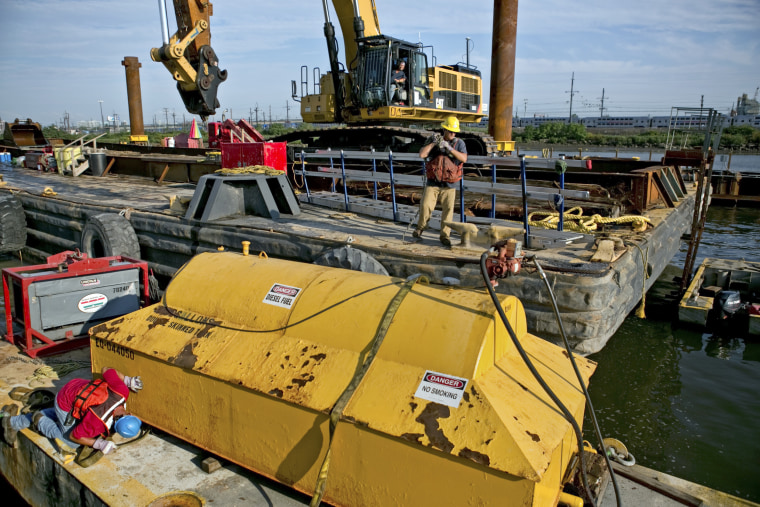
The plan involves dredging another 3.5 million cubic yards of sediment — enough to fill MetLife Stadium one-and-a-half times — and shipping the waste by rail to a disposal site outside of New Jersey. The remaining sediment would then be capped with a 2-foot-thick layer of sand from bank to bank.
The idea is to prevent an intense storm from kicking up the contaminated sludge, which locals liken to “black mayonnaise.”
The cap’s design takes climate change and sea level rise into account, said Stephen McBay, a spokesman for the EPA’s Region 2 office, which includes New York and New Jersey. Computer modeling uses “conservative assumptions” to guide how thick the cap should be and how much dredging should occur before its installation so that it “does not increase flooding potential in the future,” he added.
But even when the plan was released under the Obama administration, it drew public concerns that the models did not sufficiently account for climate-related sea level rise. The agency at the time said there remains a “large range of uncertainty” in how sea level rise will look on the local and regional levels.
The cleanup hasn’t yet begun. The EPA said the design phase won’t be completed until possibly 2022, and then it would take several more years for the work to be finished.
The agency is “progressing on an aggressive timeline,” McBay said in an email.
Even then, necessary remediation of another 9 miles of the Passaic River under the EPA’s plan would still need to occur, although when that would start is unclear.
Jeff Tittel, director of the New Jersey Sierra Club, an environmental nonprofit, said more could have been done during President Barack Obama’s second term to address the effect of climate change on Superfund sites, particularly in New Jersey, and he believes it was a missed opportunity that the Trump administration has failed to seize on.
Tittel said he worries that the EPA is removing sites from the Superfund list without fully considering acute weather events and rising sea levels in the cleanup plans.
“With Superfund sites and climate change, we’re playing Russian roulette with a loaded gun,” Tittel said of a potential disaster. “It’s a matter of when, not a matter of if.”
A price unpaid
Polluters are expected under the Superfund enforcement program to pay for the cleanup, and companies have ponied up billions of dollars toward the effort nationwide.
But in Newark, the process is complicated: The EPA identified more than 100 companies liable for the toxic waste that seeped into the Passaic and must negotiate with either them or the entities that absorbed them.
While one company — another corporate successor to Diamond Alkali, known as Occidental Chemical Corp. of Texas, part of Occidental Petroleum, one of the largest U.S. oil and gas companies — agreed in a 2016 settlement to pay $165 million for the remediation design phase, the EPA must still secure money from dozens of other companies that have evaded accountability for decades and left the project to stall.
If the companies don’t foot the bill, taxpayers may have to pay.
The EPA said that “complex negotiations” are tying up the timeline.
Communities across the country are suffering under these protracted legal battles, which only obstruct long-awaited cleanup, said former New Jersey Gov. Jim Florio, a Democrat who spearheaded the Superfund law while in Congress in 1980.
Business groups and attorneys for companies say corporations can be railroaded into paying and argue that many Superfund sites are actually former municipal landfills, so there should be a shared burden between public and private entities.
Florio, now an environmental lawyer, has supported efforts by Democratic lawmakers in Congress to reinstate a tax on the oil and chemical industries to help pay for cleanup at sites where the polluters were unknown or unable to complete remediation work. The tax expired in 1995 under a Republican-controlled Congress.
Most recently, Booker reintroduced a bill to reinstate the tax in the Senate in January after Democratic Reps. Frank Pallone Jr. and Bill Pascrell of New Jersey did so in the House last fall. But so far, the bills have languished.
Neither the White House nor the EPA have said directly whether they would support reinstating the Superfund tax.
Florio said his expectations are limited for an administration that favors deregulatory efforts and a president who “doesn’t even acknowledge climate change as being real.”
“We seem to find money for things like a border wall, but where’s the money for cleaning up problems in Newark, New Jersey?” Florio said. “It’s a matter of priorities.”
A ‘moment of reckoning’
Newark — with its vacant lots, brick tenements and a rooftop sign on the Anheuser-Busch brewery, bright like a neon North Star — welcomed Melissa Miles, a native of New York City, more than a decade ago.
She settled in the Ironbound, across from a plastics factory and the view of smoke wafting from its vents. She got used to the acrid smell and the sound of belching trucks that felt like white noise. But in 2013, a year after her oldest son was born, he was diagnosed with asthma and rushed to the emergency room.
“That’s when it became personal,” Miles said. “I was absolutely shocked. No one in my family had asthma.”

According to the EPA, about 1 in 4 children in Newark has asthma, a condition that makes breathing difficult and, in rare instances, can lead to death. The city’s asthma rate is three times the national average.
Newark residents face other health problems potentially related to long-term pollution, including higher rates of lead poisoning in children and chronic diseases, such as diabetes and hypertension, studies have shown.
Miles said her two children were diagnosed with attention deficit hyperactivity disorder, but trying to determine whether environmental factors may have affected their health is impossible.
Miles became interested in environmental justice while working with the Ironbound Community Corp. In July, she was named the executive director of the New Jersey Environmental Justice Alliance, a statewide organization that focuses on environmental issues involving low-income residents and communities of color.
The group helped get a landmark environmental justice bill passed in the state Legislature in August that will require companies to hold public hearings and gain state environmental approval if they are heavily affecting the environment or looking to build, expand or renew permits in low-income communities. Gov. Phil Murphy, a Democrat, held a bill-signing ceremony in September at an Ironbound park, waving off critics of the law who believe it will drive away new business.
Miles calls it a “moment of reckoning” for New Jersey, signifying that after decades of unhampered pollution in cities like Newark and a systemic failure to clean up toxic Superfund sites, residents now have a way of safeguarding their communities.
Baptista agrees that such protection can help prevent more pollution. But the damage remains for sites like the Passaic in Newark, where people worry about their health — particularly in the event of another mega storm and in the face of an ever-warming planet.
“What will happen when the next big flood comes?” Baptista asked.
Visiting the riverbank on a recent sunny morning after the environmental justice bill passed gave her hope that one day future generations will know the waterfront not as “the danger zone,” as she did growing up, but as the place that the people of the Ironbound never forgot.
